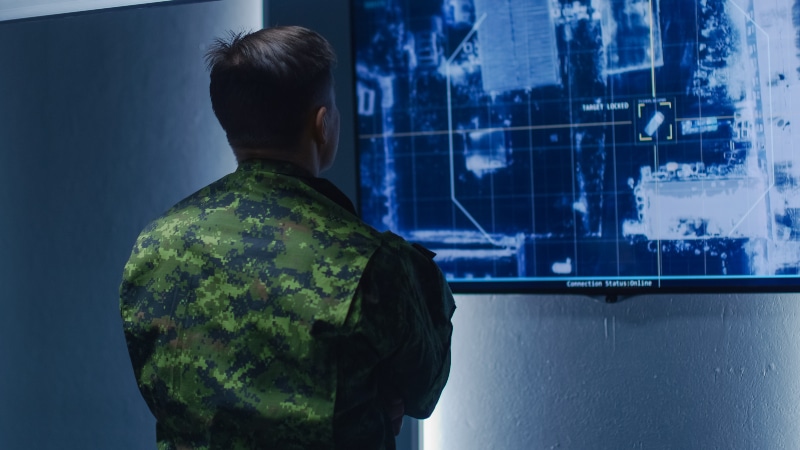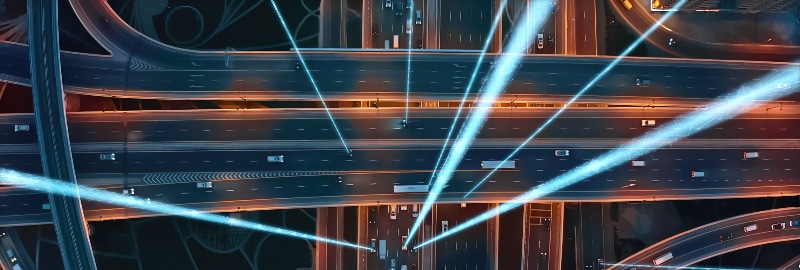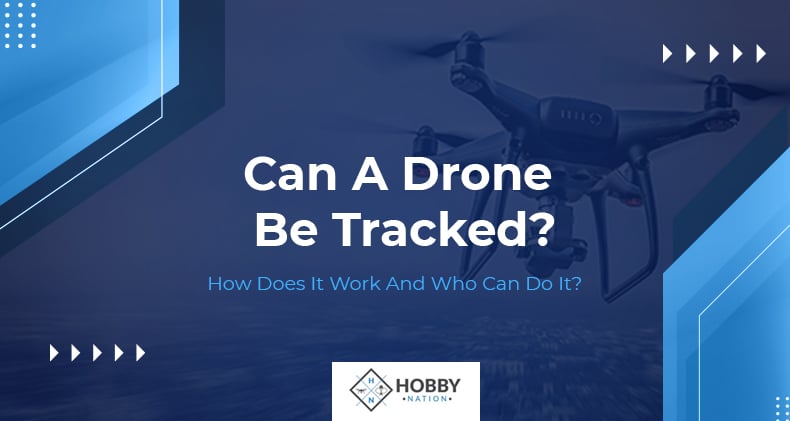Drone laws are pretty stringent, or you cannot fly drones anywhere you want, anytime you choose. You must seek written approval from local authorities. But some people fly drones without necessary permission and need to be tracked and identified for safety and security reasons as a result.
You can track an airborne drone using different hardware tools and digital solutions. The information traced, however, could vary or may not be consistent across technologies employed. Some may locate the drone pilot, but other tools may offer only details specific to the drone and not its owner.
This article will discuss drone tracking and the various technologies employed for the purpose, the existing state of UAV detection, and more in great detail. If that sounds interesting and informative, read on.
The Popularity of Drones and the Need for Tracking
A drone or UAV (uncrewed aerial vehicle) is an affordable and reliable tool for multiple applications, such as:
- ISR (intelligence, surveillance, and reconnaissance)
- Infrastructure monitoring
- Aerial photography
- Precision agriculture, etc.
The cost reduction and miniaturization of the electronic components (microprocessors, batteries, sensors, etc.) have helped commercialize small and micro drones.
If not for drones, aerial footage wouldn't have been possible or as common as they are now. Before drones, only people who had the production budget to afford helicopters or similar equipment could get and capture bird's eye perspectives of landscapes and structures.
Though a drone is quite accessible, there are rules to using the device in public. Looking at how drones are being deployed and their growing popularity, most people think drone flying laws and guidelines are much needed.
Reasons Why a Drone is Tracked
When handled by amateurs, drones could damage property and/or injure people. And when in the hands of a criminal, the drone can be used to spy on people and things, making the device a major security and safety threat.
Therefore, it becomes critical for security personnel and teams to patrol the skies for rogue drones continuously.
There are also scenarios where a drone's rightful owner could have lost their quadcopter in the middle of its flight and may need help locating it.

How Do Drone Tracking Technologies Work? Are They All the Same?
Different technologies could be employed to detect a flying drone and its activities in the air or when it's stuck in the woods. Not all drone-detecting or monitoring equipment work the same way, by the way.
Some detect the drone from other objects in the sky. A few other drone detectors could be rudimentary in their approach and may not differentiate a drone from a bird or kite, for instance.
Also, the capability of the tech employed varies with:
- The drone type
- Things the quadcopter is up to in the sky
- Its size
- How high it is in the open space, etc.
The system specifically designed to trace and seize or divert drones is called counter-drone or counter-UAV tech.
Certain detection technologies could identify a specific drone model and may even detect the drone's digital fingerprint, such as its MAC (media access control) address. Such specific information could be tracked for prosecution reasons. Some tools even let you track drone location in real-time.
Drone Monitoring Equipment/Technology Types
Radiofrequency analyzers, optical sensors, acoustic sensors, radar, etc., are the tracking techs usually employed to detect, monitor, and/or classify aerial drones.


Radio Frequency (RF) Analyzer
An RF analyzer comprises antennas and a processor. The antennas help receive the radio waves, whereas the processor assists with analyzing the RF spectrum. The unit helps identify radio interaction between a quadcopter and its controller.
Some RF systems can also detect specific drone models and makes. For that, however, the quadcopter should be relatively popular. In other words, the RF technology won't retrieve specifics about a drone made by a no-name brand or a new company.
The negative to the technology is it can track drones up to a specific (usually short) range. Also, the tech is not very effective in areas already crowded with RF signals.
Radar-Assisted Tracking
A radar device uses radio energy to identify flying drones. The radar tool sends out signals and receives reflections of the target drone, measuring the aircraft's distance and direction. These radars usually burst out the radio signals to heighten the possibility of receiving echo waves, which humans obviously cannot hear.
Radar technology is usually used to detect large objects in the sky, such as traditional airplanes. Therefore, its efficacy concerning tracking drones is kind of a hit and miss. The farther the drone from the ground, the lesser are the chances of locating it via radar tech. Also, radar technology cannot differentiate a plane or a bird from a drone. And you need a transmission license to operate the equipment.
The technology's strong points are its long range, accurate localization, constant tracking, ability to handle multiple targets' tracking concomitantly, doesn't require the right visual conditions, etc.
Radio Frequency Jammer
An RF jammer is usually the last resort or the objective to take the drone out or cause it to malfunction. The jammer is typically a handheld or mobile device (more like a gun) that transmits vast amounts of radiofrequency energy at the drone, cloaking the drone's controller signal. Upon successful jamming, the drone is likely to:
- Land perpendicularly, in a controlled manner from its current position in the sky.
- Return to its home location.
- Fall uncontrollably to the ground, or
- Fly off randomly, with no set path or direction.
RF jammers are usually employed or legally allowed to use by cops, security professionals, etc., because one cannot predict how the jammer impacts the drone's behavior or the surroundings in general. The jammer, for instance, could even set the drone off to its target inadvertently.
Jamming technology was employed to take down the rogue drones that Heathrow airport protesters used to disrupt the airport's operations.
Acoustic Sensor
As the name suggests, an acoustic sensor employs microphones to detect the sound created by a drone and compute its distance and direction from the ground. The tech is easy to deploy and relatively portable too.
Acoustic sensors equipped with advanced detection tech can sense UAVs even if they do not have radio frequency links or are not visible to radars. Security forces typically employ these sensors to detect unauthorized entry of drones into guarded zones.
The sensor tool offers live alerts and also helps collect the tracking data as evidence. The drawback, however, is that the sensors do not work well in noisy surroundings.
Optical Sensor
Optical sensors instituted to detect and track drones are essentially thermal imaging/infrared cameras. The sensors also have integrated zoom to get optically closer to the target.
Because the cameras are thermal imaging sensors, they perform well in low-lit, dark environments as well. Thermal imaging also affords the ability to detect objects irrespective of the weather outside – hot or cold.
However, a known problem with these optical detection setups is the number of false alarms or detectors they give rise to. Fortunately, you can address the problem with filtering architectures or curating the multiple detection information.
GPS Spoofing
A GPS spoofer is a radio transmitter that interferes with legitimate GPS signals and sends fake signals to a receiver's antenna. By sending an alternate signal to the flying drone, the UAV is made to believe it's positioned somewhere else.
As a result, the spoofer can control the drone's position. After control is acquired, the drone could be flown to a safer place or away from the restricted area.

High Power Microwave Device
An HPM tool produces electromagnetic pulses (EMP) that can disrupt any electronic device's functioning, including drones. The EMP impedes the radio connections and unsettles or even obliterates a drone's electronic circuitry. The drone exposed to the current could lose control and fall uncontrollably to the ground.
When used to trace and target a drone, the HPM device could impact any other electronic machine in the same range – courtesy of the destructive currents and voltage it generates. The antennas in an HPM device may help channelize the electrical energy to reduce collateral damage as much as possible, however.
Net Gun
A net-firing gun may not sound very scientific, but it's effective nonetheless and causes little to no damage to the environment. Launching a net at a UAV prohibits the rotor blades from functioning, consequently hindering the drone.
You could launch the net cannon from the ground, provided the drone is not too farther from its terrain. The hand-held, shoulder-positioned gun helps with trapping drones that are not more than 300 meters (985 feet) away. The net could be fired without or with a parachute to ensure the drone descends from the sky in a controlled fashion.
If the drone is too far for a handheld gun, you can fire the net cannon from another quadcopter. This technique, however, is as challenging to implement as it seems on paper. Most authorities use a "net drone" instead, which deploys a net on the rogue aircraft and directs it toward a safe location.
If the target UAV is relatively heavy, the net drone may capture it and subsequently release it after ushering it to a safe place. The hostage drone is set free without or with a parachute.
All of the above techniques to locate or capture a drone may be used in isolation or combined based on the situation at hand or the operation's objective.
For instance, if the aim is to simply detect or intercept a drone, techniques such as radiofrequency detection, infrared, electro-optical methods, etc., could be employed. However, if the objective is to kill or destroy the drone, jamming, laser, nets, spoofing, etc., are resorted to.
Existing Drone Detection/Tracking Tools
The drone industry has been under major scrutiny for the high-profile disruptions in the past – including incidents at Heathrow and Gatwick airports, resulting in flight delays and planes getting grounded for days.
![]()
Therefore, drone manufacturers and other companies in the space are continually working on technologies and tools that allow organizations and individuals to track such illegal drones. The following are a couple of some recent efforts:
Mobile App
DJI is working on an app that lets people track airborne drones in their vicinity on their smartphones.
If you are bothered by drones flying nearby, the application can help you learn more about them and possibly do something about them too. The best part is the app is accessible by all and not just restricted for use by security professionals, airport authorities, etc., unlike AeroScope.
DJI is the world's biggest commercial drone maker. If you see a drone flying nearby, the mini helicopter would likely be a DJI offering. However, the app is not limited to detecting DJI drones alone. It can help you learn about non-DJI drones flying around as well.
The app would let people track and find an airborne drone's remote ID, type, altitude, speed, location, etc.
The remote ID is a drone's digital license plate, letting in any person on the drone's details. Industry experts and authorities believe the ID will be instrumental in permitting more complex drone usage and solving security and safety concerns.
Drone pilots can broadcast a basic description of their drones, so anyone who uses the app understands the flight is being carried out for roof inspection, construction site survey, and other similar essential or genuine works.
Kindly note, the drone needs to be within approximately 0.6 miles (1km) for the app to detect and learn more about it. The drone should also be powered on. The app will not detect inactive, stationary drones.
The Criticism
Existing technologies don't offer much assistance in detecting rogue drones and taking their erring pilots to the task. The app is expected to be of significant help.
However, drone pilots who seek proper permission from the concerned authorities before flying their drones are not happy about the app's function or use case.
They argue it's unfair and outright wrong to give random people the ability to glean information about them and their drones even after seeking necessary approvals to fly their UAVs. Not to mention, they view the app provision as an open invitation to robbers.
Most legitimate drone users maintain that they don't have issues getting tracked by authorities, such as air traffic control and the cops. They claim providing open, unhindered access to all is dangerous and illegal.
The app was initially planned to be launched sometime in 2020. It, however, is yet to be made official, pending regulatory approval.
AeroScope
The above-discussed mobile app is not DJI's first attempt at helping authorities track drones for security and transparency reasons. Back in 2017, the Chinese technology firm developed AeroScope. Unlike the smartphone app, AeroScope could be used only by authorized personnel.
Aeroscope is a comprehensive drone detection tool that identifies most drones and gains critical information by monitoring and studying their electronic signals, letting the users safeguard their drone-sensitive environment's integrity. The platform detects UAV communication links; and gathers information such as flight paths, status, and other real-time information.
AeroScope is a robust platform. It comprises a stationary unit that can be custom-built as per specific user and site demands, thereby covering the surrounding airspace completely. In ideal conditions, the setup can monitor drones falling within a radius of up to 31 miles (50km). It can gather critical drone information in as quickly as two seconds. The stationary unit's monitoring range is ascertained by the kind of antennas installed.
The data monitoring could be integrated with current security systems (if any) for an efficient integrated monitoring setup. The AeroScope system also supports private cloud, public cloud, local deployment, etc.
Trackers for Drone Owners/Pilots
If you've never flown a drone before, it's highly advised you invest in a drone-tracking device. Even if you're a seasoned drone user, chances of losing a drone due to radio interference, software problems, loss of connection, bad weather conditions, etc., cannot be ruled out.
The above-mentioned tracking equipment are not portable or the best fit for personal use. Therefore, look at trackers that are pocketable, fit in the palm of your hands, and are inexpensive. Brands such as Trackimo, Eaglerich, Tracki, etc., offer some truly capable drone trackers. The Tracki 2021 Model Mini and Trackimo 3G Travel Tracker are particularly worth a mention.
When shopping for a personal drone tracker, give maximum priority to the device's tracking capabilities and features. In other words, look for a GPS tracker that supports different modes, including GPS, A-GSM, A-GPS, Wi-Fi, GSM, and Bluetooth.
Also, look for trackers with maximum range. A 2-mile (3.2km) range would best serve most people.
And like the drone, GPS UAV trackers too run on batteries. But luckily, their batteries last much longer than a drone's power pack. And that longevity has got a lot to do with the sporadic need to use the tracker.
Conclusion
The above-mentioned tools/platforms may not have been adopted by all drone manufacturers, or the app may still be under review by the authorities. But there's no doubt that drone detection and tracking is possible, and efforts are being continually made in the direction.
If, on the other hand, you need help with locating your lost drone, invest in a drone tracker – irrespective of whether the mini airplane you purchased is cheap or on the pricier side of things. Not to mention, the drone tracker will last you longer than your actual drone, or it can most likely track every drone you have in your arsenal.
Shawn Manaher loves to play with new toys and dive into new hobbies. As a serial entrepreneur, work definitely comes first but there is always room for hobbies.

